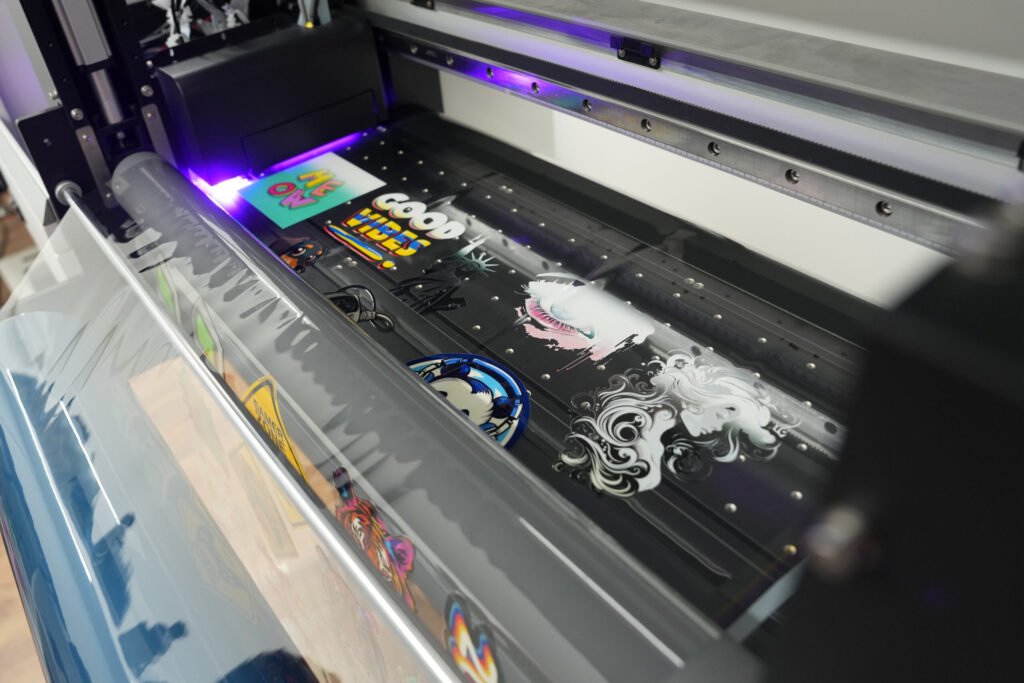Fundamental differences between UV DTF AB film and DTF film
Thin-film functionality
- UV DTF AB film: It consists of two types of films, the so-called AB film is film A and film B.Film A provides the function of ink absorption so that you can print the ink on it with a printer, while film B provides the function of release transfer.Film A and film B are combined and transferred by film B.
- DTF film: There is no specific concept of A or B film, it needs to be used in combination with DTF powder, the DTF film itself can be used for transferring, there is no such thing as merging.The film comes with an absorbent layer (ink absorption function) and a release layer (peeling function).
Transfer differences
- UV DTF AB films: The transfer of AB films requires a “film closing operation”, i.e. the heating and lamination of A and B films together before the next step of the transfer process.
- DTF film: After sprinkle powder and dithering, the film is ready for transfer by heat pressing. The film itself is used as the transfer medium.
Difference in number of product types
- UV DTF AB film: Currently there are only three different types of films on the market: standard, glitter, gold and silver foil, special films need to be customized by the corresponding manufacturer.
- DTF film: Currently there are 7 – 9 types of films on the market: matte, glitter, fluorescent, gold, silver, breathable, peelable in seconds, colored, thermochromic. Each has its own needs and advantages.
Differences in substrate applications
- UV DTF AB film: AB film is primarily used in UV printing, which is suitable for hard substrates like metal, glass, wood, acrylic, plastic, and ceramic.
- DTF film: DTF film is mainly used for textile printing, offering a highly efficient solution for fabric designs. However, due to limitations in the printing process, it cannot be used on substrates other than fabrics.


Differences in printing processes between UV DTF AB film and DTF film
UV DTF AB films and DTF films need to be used for the corresponding printing process. In other words, when you are doing UV printing, you need to use UV DTF AB film and not DTF film. When you are printing DTF, DTF film is your only choice.
If you confuse this concept and try it. Then you run the risk of all of the following.

The transfer was not successful
Different films have different transfer temperatures. In the case of UV DTF AB film, for example, it requires a laminating operation prior to transfer. The lamination of the film requires heat, and this lamination temperature is usually categorized into low-temperature lamination and high-temperature lamination. Low temperature lamination requires temperatures in the range of 40 – 45 degrees. High temperature lamination requires a temperature range of 90 – 95 degrees.
Suppose you use AB film for DTF printing. Then you will find that the film is burnt during the transfer! The reason for this is very simple, the temperature of the heat press used to transfer the DTF film is usually in the range of 145 – 165 degrees Celsius. This is not the same temperature as UV DTF film.
The differences between the two films for printing use have long determined the differences they are given in production.
Frequent errors in the operating procedure
Let’s take the above example and assume that you have not yet reached the transfer step. For the DTF printing process, you need to “sprinkle powder” and “shake” the film before transferring. The powder gives the ink some special abilities.
And when you get to the stage of needing to bake the powder, you may find a new problem: the film melted through when baking the powder!
The reason for this is simple: the temperature of the baked-to-melt powder is also higher than the limits of the UV DTF AB film. Typically, DTF printing uses special hot-melt powders to impart certain properties to the film to facilitate transfer.
These powders typically have a melting point in the range of 85 – 110 degrees Celsius. There are also different melting points depending on the type of powder used (low temperature powder or regular PU powder).
Even with low-temperature DTF powders, you need to offset the temperature of the melted powder with a UV DTF film that can withstand high temperatures. So this does not work in the printing process.

Proper understanding of UV DTF AB film and DTF film
The above example illustrates the difference between the two films.
UV DTF AB film is a consumable used for UV DTF printing. Not only is the film incompatible, but so is the ink, and UV ink cannot be used as DTF ink. It is necessary to use the appropriate consumables for the printer you are using.
I often see customers asking about commonalities between inks or other consumables. If you answer these questions from a professional point of view, it can be said that there is no commonality. Although the printing process is the same as “printing ink onto a film and then transferring it to the film”, in practice there is a big difference.
Conclusion
In short, It is important to remember that UV DTF AB film and DTF film are two different things. They correspond to their respective printing needs. They are not compatible! Haphazard use will affect productivity.
If you want to learn about DTF films, you can click here.









